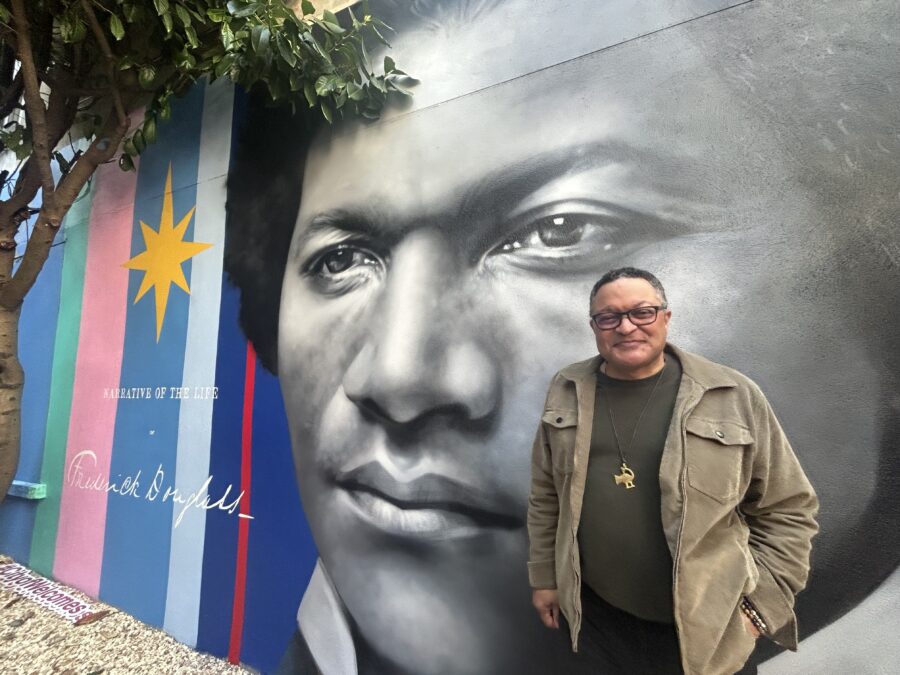Kieran’s Our City, Our Town Article,
Cork Independent, 23 May 2024
The Frederick Douglass Mural

A new wall mural has been painted on the walls of the courtyard of the Unitarian Church on Princes Street. A famed American abolitionist and civil rights leader, Frederick Douglass was a champion for human rights, equality and freedom. Visiting Cork City in 1845, Frederick delivered several orations, organised by the Cork Anti-Slavery Society and the Cork Ladies’ Anti-Slavery Society, which were very well attended and widely covered in the press. All Cork heard his message: one of tolerance, anti-prejudice – a cry against the evils of slavery.
Corkonians, of all denominations, soon to face the ruination of the Great Famine, warmly extended the hand of friendship to Frederick Douglass and his cause.
In welcoming Frederick Douglass, the people of Cork demonstrated real solidarity with an international injustice. Douglass captured the true value of meaningful and practical solidarity when he stated in relation to Cork’s international outreach: “We are made to know that there are hearts beating in unison with our own”.
Frederick Douglass made lifelong friendships in Cork, writing to the Mayor of Cork, Richard Dowden, depicted also on the mural, he highlighted the bonds of friendship; “I shall ever remember my visit with pleasure, and never shall I think of Cork without remembering that yourself and … kind friends … constituted the source from whence flowed much of the light, life and warmth of humanity which I found in that good City”.
A wonderful plaque is mounted on a reclaimed piece of Cork limestone. The plaque, which is a quote from Douglass, reads: “We have to do with the past only as we can make it useful to the present and to the future”.
The plaque upon a stone mount was completed through the wonderful artistry and craft of Liam Lavery, Eithne Ring, Christian Helleberg and Jim Fahy serve to remind us all of this. A special thanks to Reverend Mike O’Sullivan and the Cork Unitarian Church. The Church and courtyard are a special place, a place of calm, and a place of welcome to all, right in the heart of our city.
The artist Zabou, with Kerri, John and Raff at the Walls Project created this striking piece of art. Zabou notes that her design was inspired by various metaphors; “The artwork combines a realistic and confident portrait of Douglass with elements highlighting his achievements and time in Cork (such as Mayor Dowden, the North Star, his book and a map of the USA and Ireland). The vibrant colours of the background were inspired by the Unitarian Church logo”.
The project is funded by the Creative Ireland Programme, and also acknowledges the support of the Council’s Corporate Affairs & International Relations Directorate, and the Community Recognition Fund.
At the mural launch Kenneth B Morris, Junior, the great-great-great grandson of Frederick Douglass, Globe Lane Initiative board member and Co-Founder & President of Frederick Douglass Family Initiatives spoke about Frederick’s legacy.
The mural also complements a trail across the city, which in recent years has been created to trace the footsteps of the abolitionist Frederick Douglass who visited Cork in 1845, and the 12-stop route. The trail, which can be viewed online and downloaded as a pdf weaves its way across Cork City and includes iconic local landmarks such as the City Courthouse where Douglass delivered a two-hour speech titled “I Am Here to Spread Light on American Slavery”.
The Imperial Hotel was the setting for Douglass’s ‘American Prejudice Against Colour’ speech on the afternoon of Thursday, 23 October, 1845. Douglass declared at the hotel “There is nothing slavery dislikes half so much as the light. It is a gigantic system of iniquity, that feeds and lives in darkness, and, like a tree with its roots turned to the sun, it perishes when exposed to the light.”
A highlight of Douglass’s time in Cork was meeting Fr Mathew, the famed “Apostle of Temperance” whose statue bestrides St Patrick’s Street. While in Cork, Douglass stayed with the Unitarian Thomas Jennings and his family at Brown Street (now Paul Street). 74 George’s street was the setting for Douglass’s final speech in the city. It also served as the weekly meeting place for the Cork Ladies Anti-Slavery Society.
The Cork Abolitionists Trail is a legacy project of the highly successful #DouglassWeek which took place in February 2021. While Douglass was the best-known abolitionist to visit Cork, he was part of a tradition involving many other abolitionists who made the journey before and after him.
The Cork Abolitionists Trail was developed by #DouglassWeek team members Dr. Caroline Schroeter, Dr Laurence Fenton, Dr Adrian Mulligan, Kristin Leary, Dr Groenland, Dr Hannah-Rose Murray and Sarah McCreedy, with beautiful graphics and design by Dan O’Connell, and is a legacy project of #DouglassWeek.
In 2023, Cork City Council also engaged with the Frederick Douglas Family Initiatives and to meet with the Mayor of Rochester, Malik D. Evans, and to lay a wreath on Douglass’ grave in his chosen home, as part of Lord Mayor-led delegations to the US. The legacy of Frederick Douglass’ time in Cork was also a key part of the Lord Mayor-led delegation to Washington in 2022.
Caption:
1254a. Kenneth B Morris, Junior, the great-great-great grandson of Frederick Douglass at the new Frederick Douglass Princes Street mural (picture: Kieran McCarthy).



